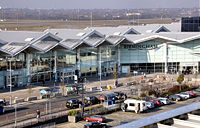Birmingham International Airport (United Kingdom)
| Birmingham International Airport | |||
|---|---|---|---|
|
|
|||
| IATA: BHX – ICAO: EGBB | |||
| Summary | |||
| Airport type | Public | ||
| Operator | Birmingham International Airport Ltd | ||
| Serves | Birmingham, England | ||
| Location | Solihull, West Midlands | ||
| Elevation AMSL | 328 ft / 100 m | ||
| Website | |||
| Runways | |||
| Direction | Length | Surface | |
| m | ft | ||
| 15/33 | 2,605 | 8,546 | Asphalt |
| Statistics (2007) | |||
| Aircraft Movements | 114,679 | ||
| Passengers | 9,226,340 | ||
| Statistics from the UK CAA[1] | |||
Birmingham International Airport (IATA: BHX, ICAO: EGBB) is an international airport located 5.5 nautical miles (10.2 km) east southeast of Birmingham city centre, in the borough of Solihull, West Midlands, England. In 2007 it was the sixth busiest airport in the UK after London Heathrow, London Gatwick, London Stansted, Manchester and London Luton, and second busiest not serving London after Manchester.
Birmingham has a CAA Public Use Aerodrome Licence (Number P451) that allows flights for the public transport of passengers or for flying instruction.
The airport is close to the M42 motorway and A45 main road. It is connected by the elevated AirRail Link with Birmingham International railway station on the West Coast Main Line.
The airport handled 9,226,340 passengers in 2007, up 0.9% from 9,147,384 in 2006, and an 18% increase over the six years since 2001.[1] It offers flights within the UK, Europe, the Indian subcontinent, the Middle East, and North America. In July 2008, the airport surpassed the 9.5 million passengers mark in a rolling 12 month period for the first time, handling a total of 9,530,628 passengers, a 4.3% increase over the 12 months to July 2007.[2]
Contents |
History
The airport was opened at Elmdon on 8 July, 1939, and was owned and operated by Birmingham City Council. During World War II, the airport was requisitioned by the Air Ministry and was used by the RAF for military purposes. During this time, the original grass strip was replaced by two hard runways: 06/24 at 2,469 feet (753 m) and 15/33 at 4,170 feet (1,271 m)[3]. Avro Lancaster bombers manufactured at the Austin Aero Company's shadow factory at Cofton Hackett could not take off from the short runways at Longbridge. Instead they were transported by road, minus the wings that would be attached at Elmdon. Test flown from the aerodrome, once declared airworthy they were then flown to their operational units. The aerodrome returned to civilian use in July 1946, though still under government control.
During the post-war years, public events, such as air fairs and air races were held on the site. The City of Birmingham took over responsibility again on January 1, 1960 and assumed full responsibility on April 1, 1960.[4] The main runway was extended in the late 1960s to allow large jet operations. Ownership of the airport passed to the newly-formed West Midlands County Council in 1974.
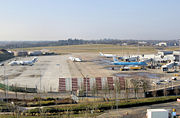
In 1984, a new terminal was opened, able to handle three million passengers a year. A second terminal, "Eurohub", the first terminal in the world to combine domestic and international passengers, opened on 26 July, 1991 (with Concorde in attendance), more than doubling the airport's capacity. The original Art Deco 1939 terminal and control tower are still visible, near hangars to the west of the runway.
In 1983, the airport was privatised, although the local authorities still own a 49% share. On 1 April 1987, the ownership of the Airport transferred to Birmingham International Airport plc, a public limited company owned by the seven West Midlands district councils.
In 1995 the Maglev Airport Rapid Transit system, which had been running between the airport and Birmingham International railway station on a 600-metre (1,969 ft) track since 1984,[5] was closed due to high cost and problems sourcing parts. A cable driven "CABLE Liner" system replaced the Maglev line and it reopened in 2003.
Concorde made a final visit on 20 October, 2003 as part of her farewell tour.
Take Off, a sculpture by the Polish artist Walenty Pytel, stands in a roundabout on the approach road. It was erected in 1985 and is 1.4 m (4.6 ft) tall. The unpolished steel sculpture was designed to commemorate 40 years of peace in Europe.[6]
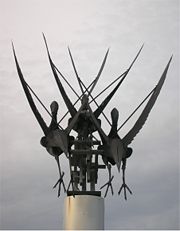
In June 2007, the airport made headlines when British TV series Tonight with Trevor McDonald revealed the findings of an investigation into airport security. They found that contractors from the company ICTS fell asleep on duty, ignored baggage x-rays and worked under the influence of illegal drugs.[7]
In July 2007, Birmingham was voted the best airport in Europe in the 5 million to 10 million passengers per year category.[8]
The shorter runway (06/24) was decommissioned in January 2008. It had been used with less frequency due to its length, noise impact, and its inconvenient position crossing the main runway making it uneconomic to continue operation. The closure also allows for apron expansion on both sides of the remaining runway.[9]
Future
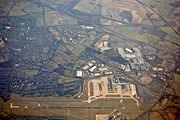
The airport has published a master plan for its development up to 2030. This sets out details of changes to the terminals, airfield layout and off-site infrastructure. As with all large scale plans, the proposals are controversial, with opposition from environmentalists and local residents. In particular the requirement for a second parallel runway based on projected demand is disputed by opponents.
The first major element is an extension to the runway, targeted for completion in time for the 2012 London Olympics. The extension will increase the runway length to 3,000 metres (9,843 ft), as well as including a starter strip to provide a maximum takeoff run of 3,150 metres (10,335 ft). The airport owners believe there is likely to be sufficient demand for long-range direct services operated by aircraft whose operation would be constrained by the current runway. At 2,605 metres (8,547 ft), this is short for an airport with Birmingham's passenger throughput and range of destinations, and limits aircraft to destinations on the east coast or in the midwest of North America, in the Gulf and Middle East, or on the South Asian subcontinent. The construction of this extension to the southern end of the runway will require the A45 Coventry Road to be diverted into a tunnel under the extended section. Plans for the extension of the airport runway and the construction of a new air traffic control tower were submitted to Solihull Metropolitan Borough Council on 7 January 2008.
Taxiways will be improved to allow for terminal expansion and to improve runway occupancy rates. One new turnoff was completed in June 2006 and has seen an improvement on traffic rates on southerly operations, where the only available option for landing traffic had been to travel to the end of the runway to turn off.
The development of Terminal 1 will see improvements made to the International Pier and a new satellite pier to the north of the terminals. The masterplan also details the need for a third terminal, which will coincide with the opening of the second parallel runway. The planned extension to the main runway will also require a new control tower to be constructed.
It was announced on 26 September, 2007 that plans for a second runway had been scrapped but plans to build another terminal and increase capacity will go ahead with works expected to finish in 2012. It is estimated that 11 million passengers a year will use the airport by 2010 and 15 million by 2013.
In June 2008 work began on the construction of the new ‘International Pier’. The new Pier will be a three storey construction; 240 metres long and 24 metres wide. Departing passengers will be accommodated on the top level, with arriving passengers on the middle level and office accommodation for airline and handling agents on the ground floor.
The new facility will provide air-bridged aircraft parking for seven wide-bodied aircraft and enough space to serve 13 smaller aircraft at any given time and will be capable of accommodating ‘next generation’ environmentally-efficient wide-bodied aircraft such as the Airbus A350 and the Boeing 787 ‘Dreamliner’ as well as the larger aircraft types such as the Boeing 777 and the Airbus A330 which currently serve the airport on a daily basis.
Airlines and destinations
Scheduled
Terminal 1
| Airlines | Destinations |
|---|---|
| Adria Airways | Ljubljana [seasonal] |
| Aer Arann | Waterford |
| Aer Lingus | Cork, Dublin |
| Air Malta | Malta |
| Air Slovakia | Bratislava, Amritsar |
| bmibaby | Aberdeen, Alicante, Amsterdam, Barcelona, Belfast-International, Cork, Edinburgh, Faro, Geneva, Glasgow-International, Jersey, Knock, Kraków, Málaga, Milan-Bergamo [ends 28 March], Murcia, Nice, Palma de Mallorca, Prague, Warsaw |
| Brussels Airlines | Brussels |
| City Airline | Gothenburg-Landvetter |
| Continental Airlines | Newark |
| Cyprus Airways | Larnaca, Paphos |
| Cyprus Turkish Airlines | Dalaman, Ercan [seasonal] |
| Eastern Airways | Isle of Man, Newcastle |
| easyJet | Geneva, Grenoble |
| Emirates | Dubai |
| Lufthansa | Düsseldorf, Frankfurt, Munich |
| Lufthansa Regional operated by Eurowings | Düsseldorf |
| Lufthansa Regional operated by Lufthansa CityLine | Munich |
| Monarch Airlines (under Monarch Scheduled) | Alicante, Almeria, Arrecife, Faro, Ibiza, Larnaca [begins 29 March], Mahon, Málaga, Murcia, Palma de Mallorca, Tenerife-South |
| Pakistan International Airlines | Islamabad |
| Scandinavian Airlines System | Copenhagen |
| Swiss International Air Lines Operated By Swiss European Air Lines | Zürich |
| Swiss International Air Lines Operated By Helvetic Airways | Zürich |
| Turkmenistan Airlines | Ashghabat, Amritsar |
| Turkish Airlines | Istanbul-Atatürk [begins 15 December] |
| US Airways | Philadelphia [seasonal; begins 13 May] |
Terminal 2
| Airlines | Destinations |
|---|---|
| Air France Operated By CityJet | Paris-Charles de Gaulle |
| Air France Operated By Brit Air | Lyon |
| Flybe | Aberdeen, Belfast-City, Bergerac [seasonal], Brest [seasonal], Chambery [seasonal], Dubrovnik, Düsseldorf, Edinburgh, Frankfurt, Glasgow-International, Guernsey, Hamburg, Hannover, Inverness, Isle of Man, Jersey, La Rochelle [seasonal], Milan-Malpensa, Newquay [seasonal], Paris-Charles de Gaulle, Split, Stuttgart, Toulouse [seasonal] |
| Flybe Operated By Loganair | Dundee |
| KLM Royal Dutch Airlines | Amsterdam |
| KLM Royal Dutch Airlines Operated By KLM Cityhopper | Amsterdam |
| Ryanair | Alicante, Biarritz, Billund, Bologna, Bratislava, Bydgoszcz, Cuneo [begins 20 December], Derry, Dinard, Dublin, Düsseldorf-Weeze, Frankfurt-Hahn, Fuerteventura, Gdánsk, Girona, Grenoble [begins 20 December], Katowice, Kaunas, Kraków, Málaga, Murcia, Olbia, Oslo-Torp, Palma de Mallorca, Perpignan, Pisa, Poitiers, Porto, Prague, Reus, Rzeszów, Shannon, Stockholm-Skavsta, Szczecin, Trapani, Trieste |
Charter Services
(All From Terminal 1)
| Airlines | Destinations |
|---|---|
| Air Transat | Toronto (Pearson) |
| BH Air | Bourgas, Varna, Plovdiv |
| Eurocypria Airlines | Larnaca, Paphos |
| First Choice Airways | Flights Under Thomson Airways |
| Koral Blue Airlines | Sharm el-Sheikh, Hurghada |
| Monarch Airlines | Arrecife, Bourgas, Calgary, Corfu, Geneva, Heraklion, Kittila, Las Palmas, Paphos, Tenerife South, Zakynthos |
| Onur Air | Antalya, Bodrum, Dalaman, Izmir |
| Thomas Cook Airlines | Alicante, Antalya, Arrecife, Bodrum, Corfu, Dalaman, Faro, Fuerteventura, Girona, Herakion, Hurghada, Ibiza, Izmir, Kefalonia, Kos, Larnaca, Las Palmas, Mahon, Málaga, Malta, Monastir, Palma de Mallorca, Paphos, Reus, Rhodes, Skiathos, Tenerife-South, Zakynthos |
| Thomson Airways | Short Haul Agadir, Alicante, Arrecife, Alghero, Antalya, Arrecife, Bastia, Bodrum, Bourgas, Chania, Corfu, Dalaman, Faro, Fuerteventura, Funchal, Geneva, Gerona, Grenoble, Heraklion, Ibiza, Innsbruck, Kavala, Kefalonia, Kos, Larnaca, Las Palmas, Lyon, Mahon, Málaga, Malta, Monastir, Naples, Palma de Mallorca, Paphos, Pula, Reus, Salzburg, Skiathos, Sofia, Tenerife-South, Thessaloniki, Turin, Venice, Verona, Zakynthos
Medium Haul Luxor, Sharm el Sheikh, Sal, Taba Long Haul Aruba, Bridgetown, Cancun, Casa de Campo (La Romana) [begins 21 December], Goa, Montego Bay Sangster, Orlando-Sanford, Puerto Plata, Punta Cana |
| Viking Airlines | Heraklion |
Cargo airlines
| Airlines | Destinations |
|---|---|
| FedEx Express | Bournemouth, Brussels, Glasgow-International, Isle Of Man, Lyon, London-Stansed, Manchester, Newcastle, Paris-Charles de Gaulle |
Incidents and accidents
- On the morning of 4 January, 2002, a Bombardier-CL604 business jet crashed on take-off from runway 15 at Birmingham.[10] The aircraft with registration N90AG was on lease by AGCO corporation and was carrying two company executives, two pilots and an observer. After arriving from West Palm Beach Airport the previous evening, the aircraft was parked overnight at Birmingham where ice formed on the wings due to the cold weather conditions. The following morning the pilots did not request de-icing of the aircraft before their flight to Bangor Airport in Maine. The ice on the wings caused one wing to dip on take off, the aircraft inverted, crashed into grass besides the runway and caught fire. There were no survivors. Sleeping pills taken by both pilots the night before the crash are thought to have been a factor in reducing the pilots' judgment.
- On 23 February, 2006, a Mahan Air Airbus A310 operating a flight from Tehran, Iran, was involved in a serious incident while on approach to Birmingham International Airport. The aircraft descended to the published minimum descent altitude of 740 ft despite still being 11 nm from the runway threshold. At a point 6 nm from the runway the aircraft had descended to an altitude of 660 ft, which was 164 ft above ground level. Having noticed the descent profile, Birmingham Air Traffic Control issued an immediate climb instruction to the aircraft, however, the crew had already commenced a missed approach, having received a GPWS alert. The aircraft was radar vectored for a second approach during which the flight crew again initiated an early descent. On this occasion, the radar controller instructed the crew to maintain their altitude and the crew successfully completed the approach to a safe landing. The accident investigation determined that the primary cause was use of the incorrect DME for the approach, combined with a substantial breakdown in Crew Resource Management. Three safety recommendations were made.[11]
- On 15 June, 2006, a TNT Airways cargo 737-300 made an emergency landing at Birmingham with damaged landing gear.[12] The aircraft, registration OO-TND, had been flying from Liege in Belgium to Stansted. Due to poor visibility at Stansted the flight diverted to East Midlands Airport. As the weather at East Midlands was also poor, the aircraft performed a full autopilot approach. During this approach the autopilot momentarily disengaged causing it to deviate from the course. The aircraft hit the grass to the side of the runway, which caused the right main gear to detach. The crew initiated a go-around, declared an emergency and diverted to Birmingham. After it landed on Birmingham's main runway, the airport was closed for a number of hours. The pilots were unharmed.[13] However, the company ascribed the incident to human error and both pilots were dismissed.[14] The official report into the accident highlighted a number of factors contributing to the accident - poor weather forecast information; A message passed from Air Traffic Control to the aircraft at an "inappropriate" time; The pilot accidentally disconnecting the autopilot when attempting to respond to the message; The pilot losing "situational awareness" and failing to abort the landing.[15]
Statistics
|
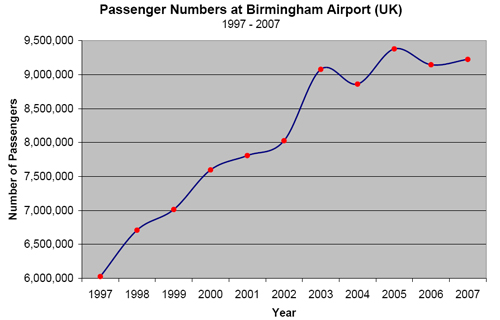 |
|||||||||||||||||||||||||||||||||||||||||
In 2007, the 10 busiest scheduled destinations at the airport were Dublin, Amsterdam, Edinburgh, Belfast, Dubai, Paris, Glasgow, Frankfurt, Malaga and Alicante. The 10 busiest charter destinations were Palma, Tenerife, Arrecife, Paphos, Dalaman, Las Palmas, Heraklion, Fuerteventura, Larnaca and Ibiza. [17]
See also
- Transport in Birmingham
References
- ↑ 1.0 1.1 1.2 Aircraft Movements - 2007, Terminal & Transit Passengers - 2007
- ↑ Airport Celebrates Three New Passenger Records in July
- ↑ "The History of Birmingham International Airport". Birmingham International Airport. Retrieved on 2008-04-29.
- ↑ The Aeroplane and Astronautics. Temple Press. 1959. pp. 252.
- ↑ Vladimir Zakian (2005). Control Systems Design: A New Framework. Springer. pp. 328. ISBN 1852339136.
- ↑ Noszlopy, George Thomas; Jeremy Beach (1998). Public Sculpture of Birmingham. Liverpool University Press. pp. 12. ISBN 0853236925.
- ↑ ITV webpage on the Tonight programme
- ↑ "Birmingham Airport Award". Airports Council International. Retrieved on 2007-11-27.
- ↑ "End of an Era as Airport Permanently Closes Runway". Birmingham International Airport. Retrieved on 2008-04-29.
- ↑ "AAIB Report on N90AG accident"
- ↑ "Report on the serious incident to Airbus A310-304, registration F-OJHI, on approach to Birmingham International Airport on 23 February 2006". UK AAIB. Retrieved on 2007-12-28.
- ↑ "AAIB Report on OO=TND incident"
- ↑ "Aviation safety network summary of TNT accident"
- ↑ "BBC News article, 27 July 2006 - Cargo plane crash pilots sacked"
- ↑ "Cargo flight 'a near catastrophe'". BBC News Online. Retrieved on 2008-04-29.
- ↑ Number of Movements represents total air transport takeoffs and landings during that year.
- ↑ "Year Ends With Record Month". BIA. Retrieved on 2008-03-10.
- United Kingdom AIP
External links
- Birmingham International Airport - Official website
- Airport Consultative Committee
- MADE IN BIRMINGHAM Elmdon Airport
|
|||||||||||||||||||||||
